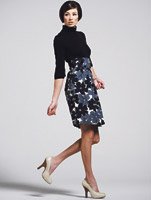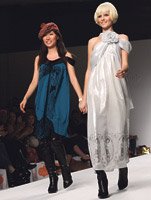Made in California, Part II: A Special Report
The second in a continuing series of apparel and accessory brands that are “making it” in California
A.B.S. by Allen Schwartz
Contemporary label A.B.S. by Allen Schwartz has been produced in California since the brand’s inception in 1982. Currently, 98 percent of the co1llection (including sportswear, dresses, gowns, and denim) is produced in the Los Angeles metropolitan area. Samples and all design aspects are handled at the company’s headquarters, and mass production is sourced to local independent contractors. The recently launched footwear collection, however, is produced overseas.
Advantages: “Producing in California versus overseas allows us to be hands-on with the manufacturing and production process,” says Schwartz. “We can turn on a dime, reacting quickly to trends in the contemporary marketplace, opposed to other competition that manufacture overseas, taking months.”
Quantities: “We manufacture from 200 to 30,000 of a particular style, depending on our needs.”
www.absstyle.comCity Threads
Joe Willis and Shayna Samuels of the kidswear brand City Threads produce 100 percent of their line with independent contractors in Los Angeles. The line is primarily focused on clothes for little boys, with stylish pants, soft tees, and hoodies with cool graphics. “I am proud to have everything made here,” says Willis. “Not only is it the best way to make sure the quality is always first-rate, but the contractors and suppliers in L.A. are great and need business. I’d much rather give the work to them than to people I don’t know and have to worry every time a shipment comes in if it’s going to be right.”
Advantages: “We can watch the production every step of the way, and we can do small custom orders for retailers,” says Willis. “We do a cut-to-order business, which minimizes our inventory and gives stores exactly what they want.”
Disadvantages: “We have to charge high prices to cover our costs,” says Samuels.
www.citythreads.comFNA Goods
Los Angeles designer Florice Houde of FNA Goods has been producing her ready-to-wear line locally since 2005. The label originated in 1998 as a custom design business serving the entertainment industry with one-of-a-kind pieces. The FNA collection is focused on outerwear with influences from music and popular culture. Houde considers herself a hands-on person and enjoys being part of the production process. Given the modest size of her company, it’s important to have production handled in close proximity to her design studio. “I source all of my materials through California,” says Houde. “I try to get materials that are made here, but it is impossible to get everything. I always use import companies that work in California, so I feel like I have direct contact with someone local.”
Advantages: “I get better-quality items by being close by and can really demand more from my contractors and develop relationships that are solid. I also take a lot of pride in the fact that my garments are produced locally. I am supporting my community. There is something special and intimate about that.”
Disadvantages: “Perhaps I pay a bit more to get things done, but after you consider traveling to off-shore production facilities, freight, and having to correct problems, it may balance out. Also, when you produce offshore, you have to have a lot of lead time and I like to be closer to my delivery time design-wise. The market is so saturated with ’instant’ fashion lines that I need to compete with that on a higher-end scale.”
www.fnagoods.comPlush Premium Denim
Los Angeles apparel company Evolushion3 launched Plush Premium Denim in 2006. The entire line is produced in California using off-site independent contractors. Most of the fabrics are sourced from Japan and Italy. “I love the quality that California denim factories and wash houses offer,” says Cindy Lang, co-founder and designer.
Advantages: “Much faster turn times and much more control.”
Disadvantages: “Price. But the advantages far outweigh the disadvantages for me.”
www.plushpremiumdenim.com Porridge
Contemporary label Porridge launched in 2004 and continues to use California-based independent contractors for production of the entire line. “Knowing that production is being made with contractors that have good labor practices and that the quality of the merchandise is up to U.S. standards gives a real peace of mind,” says designer Laura Stang.
Advantages: “You have a better hand on your production and are able to catch problems as they arise.”
www.porridgeclothing.com Three Dots
Launched in 1995 to “create the perfect T-shirt,” Three Dots has evolved into a full contemporary line for men and women, including a maternity collection. Everything except for cashmere and some wovens is produced in California, with much of the process handled in-house. “The bulk of our fabric is from local mills, thereby allowing us to have more control over sourcing. Our partnerships with local vendors create better relationships and foster a mutual interest in the well being of our businesses.”
Advantages: “Quality and speed to market in manufacturing goods. Local manufacturing also allows us to effect trends quickly.”
Disadvantages: “Limited labor pool/cost structure, but this is offset by allowing us the ability to effect trends quickly.”
www.threedots.comUS Rags
Based on California styles from the 1970s, US Rags’ tagline is “Made with love in California.” Since the label’s inception in 2002, the line has been produced in Los Angeles, utilizing a lot of vintage fabrics from local warehouses. “I wanted all the production steps to be made here, including the fabric,” says Eleanor Haycock, designer and sales manager. “Our customers know the value of California-made items. If it couldn’t be done here, we just wouldn’t do it.”
Advantages: “Speed and minimums. The relationships that we have built between sample makers, cutters, sewers, and screen printers allows us to personally go to each person and location and make the quantity we need in the time frame we need it. It also allows us much more control over the quality of garments.”
Disadvantages: “The biggest issue is as the level of complexity goes up, the price differs greatly from what can be made overseas.”
Quantities: “We do three major production cycles a year and smaller production runs for re-orders—in total about 50,000 garments a year.”
www.usragsclothing.comVanitas
Latin for “the Vanities,” Vanitas is designed by three sisters: Taryn Band, Katie Wacha, and Jennifer Band. Creating feminine pieces with timeless appeal, they strive to offer vintage-inspired pieces with a modern flair. Since its inception, the line has been produced from start to finish by an independent contractor in downtown Los Angeles, and the designers are intent on keeping production in Southern California for the entirety of their careers.
Advantages: “We can see all steps of production from start to finish, controlling the quality for the whole manufacturing process. And we also love supporting the local economy.”
Disadvantages: “Our cost basis is definitely higher, and many local companies are being priced out of the market by overseas manufacturers.”
Quantities: “We ship over 750 pieces a month. This year our numbers are over 1 million, and next year we are on track to ship 2 million plus.”
www.vanitasofcalifornia.comVoom
Designer Joy Han co-founded the line Voom with her husband, James Kim, in 2002 and began mass production in California in May of 2005. The line is comprised of contemporary tops and dresses with a “twisted vintage” vibe. An off-site independent contractor produces the Los Angeles-based line, and many materials are sourced from California.
Advantages: “The turnaround time is much faster, and we can produce re-order merchandise quickly.”
Quantities and sales: “Anywhere from 150 to 600 pieces. Our projected annual sales for 2007 are estimated at $9.6 million.”Woo
Since 1997, when Staci Woo launched her label with bags, Woo has used local production facilities. The line has since expanded to include jersey knits and an intimates line, Underwoo. Currently, off-site independent contractors do 90 percent of production in Los Angeles. Most of the fabrics are from local mills.
Advantages: “We can accommodate a quicker turn time and oversee the production on a day-to-day basis. If we anticipate any problems, we can resolve certain issues before it is too late.”
Disadvantages: “Prices are higher, and you are responsible for most of the problems that occur. Participating in every detail of the production process can be extremely tedious if you aren’t focused.”
Ziji
Designers Katerina Gabbro and Nansi Aluka of the Los Angeles–based contemporary label Ziji have used local independent contractors since the inception of the line. “We source most of our fabrics from Italy and silks from Korea,” says Aluka, “but from a local distributor. Buttons and trims: some local, some European from local distributors.”
Advantages: “For us, as a small company, the advantages of having our manufacturing here are quality control, smaller lead times, and having a personal relationship with the production house. In this fast-paced industry, it helps to have that, since we create brand new looks each season, and that makes our production even more challenging. There is also the issue of supporting the local economy and being partially green by avoiding unnecessary freight.”
Disadvantages: “It’s more expensive to produce here, and sometimes more difficult to find people who have the necessary training.”
























